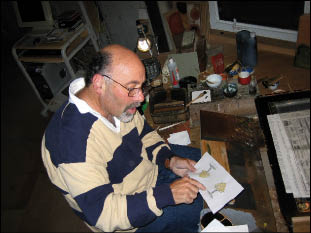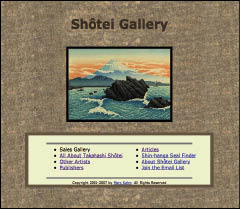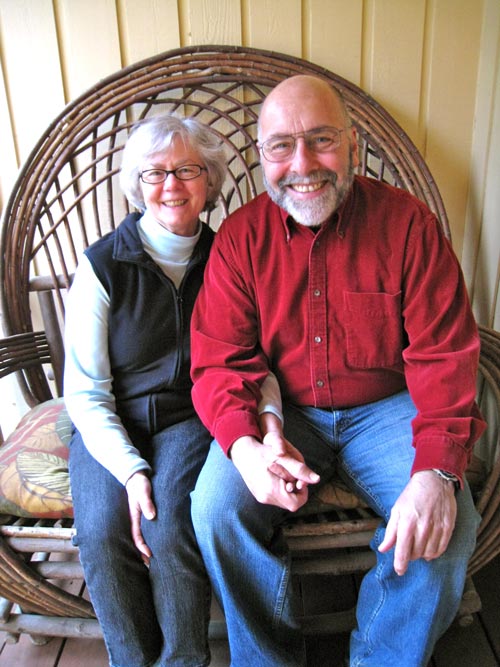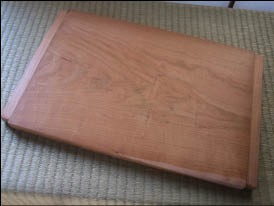Collector Profile - Mr. Marc Kahn
Due to the nature of my business, I'm never quite sure how to refer to the people to whom I send my prints. Are they 'customers'? Well, because we exchange money for products, I guess that's the technical term, but it really doesn't seem suitable for this situation. I usually use 'collectors' (as I have done with the title of this series), but that sometimes tends to make people seem a bit like children gathering stamps for an album. To use 'patron' or 'sponsor' would sound somewhat pretentious to me, I think; we're no longer in Mozart's day!
But all of this is a bit academic, because all of those words frequently become redundant. My first contact with most of the people taking my prints may be in the neutral form of an email or a written order form, but after a few prints have flown off to this new home, and we've had a bit more contact with each other, a much simpler term usually seems more appropriate - friend.
So today's little story isn't so much introducing you to somebody who is purchasing my prints, as letting you meet one of my friends!
Marc Kahn and I go back just over ten years, when I 'met' him through the activities of an internet group researching the shin-hanga print genre. They had been asking me questions about the craftsmen who made prints in their collections, some of whom were actually still alive, and I had been able to supply information to fill in some of the blanks in their data.
 But Marc had more than a casual interest, and as I learned when I got to know him better, he is somewhat of a fanatic about this topic. His particular area of interest is the early days of the shin-hanga movement, and of how it developed out of the earlier ukiyo-e. He has a special affection for one of the first artists working with the medium - the artist we know as Takahashi Shôtei - and has become pretty much the top expert on his life and work. Early on in his studies, Marc realized that the (then new) internet offered tremendous possibilities for research and education, and began building a website where he could publish his findings, with the thought that it could perhaps become a resource for others working in the field.
But Marc had more than a casual interest, and as I learned when I got to know him better, he is somewhat of a fanatic about this topic. His particular area of interest is the early days of the shin-hanga movement, and of how it developed out of the earlier ukiyo-e. He has a special affection for one of the first artists working with the medium - the artist we know as Takahashi Shôtei - and has become pretty much the top expert on his life and work. Early on in his studies, Marc realized that the (then new) internet offered tremendous possibilities for research and education, and began building a website where he could publish his findings, with the thought that it could perhaps become a resource for others working in the field.
That website is shotei.com, and his supposition on its usefulness has indeed been confirmed. These days, whenever one reads a recent book about the history or development of the shin-hanga genre, it invariably contains any number of footnotes giving credit to shotei.com for research assistance. Many years ago, back in the early days of western study of ukiyo-e, it was enthusiastic and deeply knowledgeable amateurs who were the driving force behind the research, and in our own day it is men like Marc who maintain that tradition.
I used the word 'amateur' simply to indicate that Marc - like me - works independently, and not with the affiliation of an academic institution. He has a normal job (as a software designer) and the print research is conducted in the 'After Five' portion of his day, although in his case, because he works at home and on his own schedule, the exact position of the hands of the clock don't seem to mean much, as my email Inbox can sometimes testify, with the appearance of something from him at what must be 5 in the morning his local time! (Oh, the heavy sacrifices we print researchers make ... slaving over our hot scanners and old catalogues all night!)
Given that the shin-hanga genre is relatively recent history (early 20th century), there are still people alive today who have connections to its roots, and part of Marc's work involves tracking these people down and recording their stories. He was over here in Japan a couple of years ago, visiting the grandson of a Japanese man who ran a print publishing outfit in New York City in the pre-war years. The information flow goes both ways, as Marc is not just gathering information from this kind of source, but can in turn teach them things they would otherwise not have known about their predecessors.
 I have to confess that some of the research Marc and his compatriots do - trying to pin down exactly when a particular edition of a print may have been published, for example - is not really of interest to me, but the wider aspect of it - developing an understanding of just how this genre came into being and subsequently matured - very much is. There is a fascinating story still waiting to be told - the story of how some publishers with insight created a 'vision' of how woodblock printmaking could develop, then corralled the resources of designers who were able to put these images down on paper, as well as some very highly skilled craftsmen capable of making those visions come to life, and put them all to work together.
I have to confess that some of the research Marc and his compatriots do - trying to pin down exactly when a particular edition of a print may have been published, for example - is not really of interest to me, but the wider aspect of it - developing an understanding of just how this genre came into being and subsequently matured - very much is. There is a fascinating story still waiting to be told - the story of how some publishers with insight created a 'vision' of how woodblock printmaking could develop, then corralled the resources of designers who were able to put these images down on paper, as well as some very highly skilled craftsmen capable of making those visions come to life, and put them all to work together.
The legacy those men created makes up a very important chapter in the history of 20th century art, or at least it will, once these researchers have put all the pieces together, something they are still quite some way from achieving.
Some years back, when Marc decided to add my prints to his - very extensive - collection, I was of course happy about this, but each time I send off the package containing the most recent print, I feel a little twinge as I do so; this little print of mine is about to take its place in a very substantial collection of Japanese prints that includes the work of all the great 20th century designers. It is very gratifying to have my work accepted in this way, but it is also somewhat unnerving.
Having among my collectors someone with eyes that carefully tuned to every nuance of the best work ever created ... well let's just say that it does help keep me on my toes!
Marc, for your wonderful support for so many years, and for your hard work helping to build up this body of knowledge, thank you!

 The weather reports these days show that most of Japan is having a very tough time of it - deep snows, storms, and extreme temperatures. But here in this corner of the Kanto plain, I see nothing but beautifully clear and blue skies day after day. I suppose my turn will come, but for now, I am enjoying this perfect weather for printing!
The weather reports these days show that most of Japan is having a very tough time of it - deep snows, storms, and extreme temperatures. But here in this corner of the Kanto plain, I see nothing but beautifully clear and blue skies day after day. I suppose my turn will come, but for now, I am enjoying this perfect weather for printing!


 But Marc had more than a casual interest, and as I learned when I got to know him better, he is somewhat of a fanatic about this topic. His particular area of interest is the early days of the shin-hanga movement, and of how it developed out of the earlier ukiyo-e. He has a special affection for one of the first artists working with the medium - the artist we know as Takahashi Shôtei - and has become pretty much the top expert on his life and work. Early on in his studies, Marc realized that the (then new) internet offered tremendous possibilities for research and education, and began building a website where he could publish his findings, with the thought that it could perhaps become a resource for others working in the field.
But Marc had more than a casual interest, and as I learned when I got to know him better, he is somewhat of a fanatic about this topic. His particular area of interest is the early days of the shin-hanga movement, and of how it developed out of the earlier ukiyo-e. He has a special affection for one of the first artists working with the medium - the artist we know as Takahashi Shôtei - and has become pretty much the top expert on his life and work. Early on in his studies, Marc realized that the (then new) internet offered tremendous possibilities for research and education, and began building a website where he could publish his findings, with the thought that it could perhaps become a resource for others working in the field. I have to confess that some of the research Marc and his compatriots do - trying to pin down exactly when a particular edition of a print may have been published, for example - is not really of interest to me, but the wider aspect of it - developing an understanding of just how this genre came into being and subsequently matured - very much is. There is a fascinating story still waiting to be told - the story of how some publishers with insight created a 'vision' of how woodblock printmaking could develop, then corralled the resources of designers who were able to put these images down on paper, as well as some very highly skilled craftsmen capable of making those visions come to life, and put them all to work together.
I have to confess that some of the research Marc and his compatriots do - trying to pin down exactly when a particular edition of a print may have been published, for example - is not really of interest to me, but the wider aspect of it - developing an understanding of just how this genre came into being and subsequently matured - very much is. There is a fascinating story still waiting to be told - the story of how some publishers with insight created a 'vision' of how woodblock printmaking could develop, then corralled the resources of designers who were able to put these images down on paper, as well as some very highly skilled craftsmen capable of making those visions come to life, and put them all to work together.

 Before filming began, the main producer for the program came to visit me, not once, not twice, but three times. Each time he was here, we discussed various ideas for the program. I of course (as readers of this newsletter well know) have plenty of ideas for a program like this, so was quite happy to explain this and that about my work, while he made notes and listened. He and his co-workers then put together the outline of a script for the program, which host Peter Barakan and I were to follow.
Before filming began, the main producer for the program came to visit me, not once, not twice, but three times. Each time he was here, we discussed various ideas for the program. I of course (as readers of this newsletter well know) have plenty of ideas for a program like this, so was quite happy to explain this and that about my work, while he made notes and listened. He and his co-workers then put together the outline of a script for the program, which host Peter Barakan and I were to follow. Once at the studio, we all got to work; the NHK crew was of course very efficient, and as both Peter and I have a fair amount of experience at this sort of thing, things proceeded smoothly. In order to make our conversation sound natural to the listeners, we certainly didn't try to stick to the script word for word. Peter simply led me in the proper directions with his questions, and we let the words come out naturally. When we were in the final segment of the program, I had just finished replying to a question about my current work by explaining the concepts behind the 'Mystique' series, and paused for a moment, waiting for the next cue about where to take the conversation. At that moment the producer, who was standing in front of us just out of camera range, made a gesture to me - he pointed to his shirt pocket, and then to mine.
Once at the studio, we all got to work; the NHK crew was of course very efficient, and as both Peter and I have a fair amount of experience at this sort of thing, things proceeded smoothly. In order to make our conversation sound natural to the listeners, we certainly didn't try to stick to the script word for word. Peter simply led me in the proper directions with his questions, and we let the words come out naturally. When we were in the final segment of the program, I had just finished replying to a question about my current work by explaining the concepts behind the 'Mystique' series, and paused for a moment, waiting for the next cue about where to take the conversation. At that moment the producer, who was standing in front of us just out of camera range, made a gesture to me - he pointed to his shirt pocket, and then to mine. I cannot use this knife because I am too young, and still depend too much on physical strength while using my tools. It is the same thing when I pick up my baren to print. I push too hard. I can feel that I am pushing too hard. Any craftsman in any field, or any cook in any kitchen for that matter, knows that good knives and other tools will for the most part, work 'by themselves'.
I cannot use this knife because I am too young, and still depend too much on physical strength while using my tools. It is the same thing when I pick up my baren to print. I push too hard. I can feel that I am pushing too hard. Any craftsman in any field, or any cook in any kitchen for that matter, knows that good knives and other tools will for the most part, work 'by themselves'.


